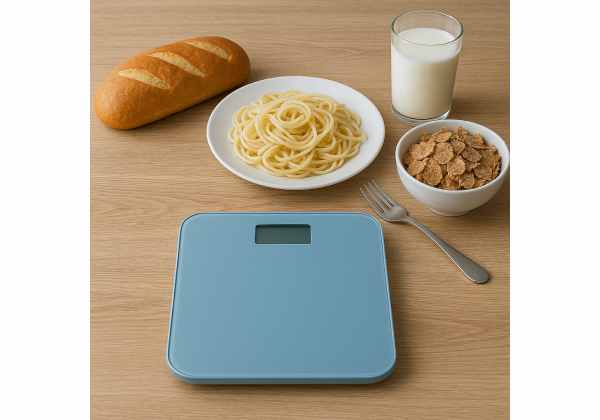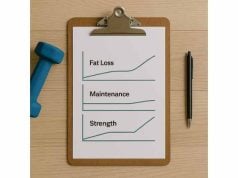
After a low-carb phase, adding pasta, rice, or fruit often makes the scale jump. That can feel like “undoing” your progress, but most of the early bump is water and glycogen, not fat. Understanding the mechanism—and using a short, structured reintroduction—prevents panic and keeps you moving toward your goal. This guide explains what a normal spike looks like, how long it lasts, and how to ramp your carbs without bloating or losing momentum. If you also need a bigger picture flowchart for stalls and maintenance, keep our concise plateau troubleshooting guide handy.
Table of Contents
- Carb reintroduction weight spike explained
- How much weight and how long
- Reintroduce carbs step by step
- Sodium, fiber and gut content
- Training, glycogen and performance
- When a spike is not normal
- Decide your next move
- Frequently Asked Questions
Carb reintroduction weight spike explained
The carb reintroduction weight spike has three main drivers: glycogen storage, water retention from sodium and carb intake, and more food volume in your digestive tract. All three are temporary. None require aggressive fixes.
Glycogen and water.
Carbohydrates are stored as glycogen in muscle and liver. For every gram of glycogen, your body binds roughly 3 grams of water. If you raise carbs by 150–300 grams per day after a low-carb phase, you can store several hundred grams of glycogen in a few days—bringing 1–2 kg of associated water. That is useful fuel for training, not fat.
Sodium changes.
Low-carb phases often reduce insulin and lower sodium and water retention. When you add carbs, insulin rises modestly and your kidneys hold slightly more sodium. Restaurant food and bread products are saltier than you think, so the first week often includes extra water simply from higher sodium.
Gut contents (food weight).
Carb-rich foods tend to be bulkier and higher in fiber. Extra food in the gut can add 0.3–1.0 kg until digestion catches up. That weight leaves as the meal passes; it is not tissue gain.
Fat gain vs. water.
Body fat does not appear overnight. Adding 1 kg of fat would require a ~7,700-calorie surplus above maintenance. Even a generous “carb celebration” weekend rarely reaches that surplus. The early bump is almost always water + food weight.
Why this is good news.
Glycogen and the water that travels with it improve your ability to produce force, recover between sets, and feel strong again. You will likely notice better pumps, higher reps, and a steadier mood. Those are the exact conditions that help you keep (or build) muscle while continuing fat loss on a sane plan.
If you are returning to fat loss after this ramp, make sure your foundation—calorie awareness, protein, and step targets—is dialed in. A quick refresher lives in our concise weight loss guide.
Key takeaway: The first few days of carb reintroduction raise glycogen, water, and gut content. Expect it. It is fuel and transient weight, not lost progress.
How much weight and how long
People want numbers. Here are realistic ranges so you can separate normal from concerning.
Typical ranges (first 3–7 days)
- Recently low-carb (≤75 g/day), now moderate (150–250 g/day):
Expect 1.0–2.5 kg up, mostly gone by days 4–10 as your body stabilizes. - Very low-carb or ketogenic (<50 g/day), now moderate/high (200–350 g/day):
Expect 1.5–3.5 kg up, often peaking by day 3–5, then settling across 1–2 weeks. - Already moderate carbs (150–200 g/day), now higher (250–350+ g/day):
Expect a smaller bump, 0.5–1.5 kg, smoothing within 3–5 days.
What determines the size of the spike
- Starting muscle mass. More muscle = more glycogen storage = bigger initial water shift.
- Training volume. Heavier training soaks up glycogen faster and stabilizes weight sooner.
- Sodium intake. Salty meals exaggerate the first-week bump.
- Fiber jump. An abrupt jump to very high fiber slows GI transit initially.
The “rule of two averages.”
Do not evaluate the change based on a single morning. Compare the 7-day average before reintroduction to the 7-day average in week 2. That comparison filters out the first-week noise and shows the true new baseline.
What is not normal
- Continued climb beyond 10–14 days without a new training phase or obvious dietary changes.
- Rapid abdominal distension, pain, or ongoing GI distress (investigate food intolerances, fiber types, or medical causes).
For a quick refresher on why scale numbers bounce with water and glycogen—and how to interpret them—skim our short explainer on water and glycogen.
Key takeaway: A 1–3 kg jump in week 1 is routine. Judge progress by 7-day averages and by week 2–3, not by the first few mornings.
Reintroduce carbs step by step
Here is a practical, 2–4 week protocol. It keeps training strong, digestion calm, and scale noise predictable.
Week 1 — Set your floor and pick clean sources
- Protein anchor: 0.7–1.0 g per lb of goal body weight, divided across 3–4 meals.
- Carb floor: start with 1.0–1.5 g per lb of lean body mass or 30–40% of calories if you do not track lean mass.
- Sources: easy-to-digest carbs first—white rice, potatoes, oats, fruit, low-fat dairy. Keep legumes and very high-fiber grains modest for now.
- Meal timing: put 40–60% of your daily carbs near training (pre/post); spread the rest across meals.
- Hydration and electrolytes: drink regularly and salt your food to taste; do not swing from “no salt” to “extra salty” overnight.
Week 2 — Progress carbs and add variety
- Increase carbs by 25–50 g/day if your energy and digestion feel good.
- Add whole-grain breads, pasta, legumes in moderate portions.
- Keep fat moderate to avoid stacking calories while you relearn portions.
- Continue weighing a few staples (rice, oats) so portion sizes are consistent as your eyes recalibrate.
Weeks 3–4 — Set your lasting pattern
- Land at a comfortable intake that supports training and recovery (often 40–50% of calories for active people, but individual ranges vary).
- Reintroduce “social carbs” (sushi, pizza, dessert) within a structured week: choose either dessert or drinks on a given night, not both.
- Watch the 7-day average weight and weekly waist. If weight rises >1–2% and the waist grows, tighten portions or bring carbs slightly closer to workouts.
Two useful nudges if you feel puffy
- Carb cycling (light version): slightly higher carbs on lifting days, slightly lower on rest days, with weekly calories roughly steady.
- Slight deficit test: pull 100–150 calories on most days for 10–14 days and reassess trendlines.
If you are transitioning back toward maintenance after a long cut, the slower, structured approach in reverse dieting steps can help you avoid over-correcting on hunger.
Key takeaway: Add carbs in small, weekly steps, place them around training, and keep protein steady. Stability beats speed.
Sodium, fiber and gut content
Not all carb sources behave the same. The first week is smoother when you manage sodium, fiber type, and food volume.
Sodium: keep it consistent
- Restaurant food is often 2–3× saltier than home cooking. If your first carb meals are takeout or pizza, the spike will look bigger and last longer.
- Action: cook most meals at home for the first 5–7 days. If you eat out, drink water, skip extra sauces, and avoid back-to-back high-sodium nights.
Fiber: ramp up, do not jump
- After a low-carb phase, your gut may be sensitive to sudden high-fiber loads (beans, bran, huge salads).
- Action: add 5–10 g of fiber per day across a week instead of jumping by 20–30 g overnight. Prefer soluble fiber (oats, fruit, legumes) to start; add more insoluble fibers as tolerance improves.
Food weight and transit time
- Carb sources with more water (fruit, boiled potatoes) feel lighter than dense, dry foods (granola, crackers).
- Action: front-load higher-water carbs early, then introduce dense snacks once you know your portions.
Digestive cues to watch
- Green flags: regular digestion, mild fullness after meals, stable energy.
- Yellow flags: persistent bloat, new reflux, or stool changes lasting >3–5 days—reduce fiber, swap sources, and space meals.
- Red flags: sharp pain, vomiting, or significant, ongoing GI distress—speak with your clinician.
To keep your readings honest during this transition, use a simple, repeatable weigh-in protocol and compare weekly averages, not single mornings.
Key takeaway: Keep sodium steady, fiber gradual, and food volume predictable. That minimizes noise and shortens the “puffy” window.
Training, glycogen and performance
Reintroducing carbs changes training almost immediately. Expect your work capacity to rise and your rate of perceived exertion to drop at a given load.
What improves with carbs back on board
- Higher reps and better bar speed at familiar loads as muscles refill glycogen.
- Shorter rest times without gassing out.
- Better pump and mind-muscle connection, which often improves technique.
- Post-workout mood and recovery feel steadier with carbs before and after training.
Programming tips for the first two weeks
- Keep your exercise selection the same; add reps before load to let joints and connective tissues adapt.
- Spread volume across the week rather than cramming it into one day.
- Place 40–60% of daily carbs near training (a pre-workout snack and a post-workout meal).
- If you were training low-carb, expect bodyweight to be higher on the bar (dips, pull-ups) for a few days; it normalizes as you adapt.
What not to do
- Do not try to “outrun” the water bump with extra HIIT. That adds inflammation and can extend the period of water retention.
- Do not confuse soreness-related water with fat gain. New volume can hold water for 48–72 hours.
If training ever feels worse after reintroducing carbs, revisit sleep, session timing, and your overall plan. Our notes on performance cues can help you troubleshoot whether the issue is programming, recovery, or food placement.
Key takeaway: Carbs restore fuel and volume tolerance. Progress reps first, keep sessions steady, and let the scale settle.
When a spike is not normal
Most spikes settle within 7–14 days. Investigate if any of the following apply.
Red flags for medical review
- Persistent GI issues (pain, diarrhea, constipation) for more than a week after reducing fiber load and spacing meals.
- Unexplained edema in hands or feet, shortness of breath, chest discomfort.
- Rapid, sustained gain (>3–4% body weight) over 2–3 weeks without large calorie increases.
Context that complicates the picture
- Medications (some antidepressants, antipsychotics, mood stabilizers, steroids, and others) can alter appetite, water handling, or energy.
- Hormonal changes (menstrual cycle, perimenopause) can add fluid shifts on top of glycogen changes.
- Very high sodium intake for days in a row (holidays, travel) delays the return to baseline.
Structured troubleshooting (7 days)
- Cook at home, moderate sodium, and limit alcohol.
- Keep carbs steady day to day; avoid big swings.
- Maintain steps and bedtime consistency.
- Track the 7-day weight average and waist.
- If both rise for two weeks, reduce 100–150 calories/day or add 1,500–2,000 steps/day and reassess.
If you suspect your medications are contributing, bring your notes to your clinician and discuss options. For a quick checklist of common culprits to review with a professional, see our overview of medication-related stalls.
Key takeaway: If the spike persists beyond two weeks, or you have symptoms beyond normal bloating and water shifts, troubleshoot methodically and involve your clinician.
Decide your next move
Once your weight stabilizes (usually by week 2–3), choose the path that fits your goal for the next 4–8 weeks.
Option 1 — Maintain to consolidate
Hold calories and training steady. Use this time to practice eating out, refine portions, and set PRs. This is ideal if your look improves weekly and you enjoy the food flexibility.
Option 2 — Small deficit to lean out
If you have fuel and good workouts but want a sharper look, trim 100–200 calories/day (usually from carb or fat) and keep protein high. Expect a slow weekly loss with stable performance.
Option 3 — Performance push
Feeling strong? Keep calories at maintenance and increase training volume slightly. Chase rep PRs and skill work. Evaluate body composition mainly by waist and photos.
How to judge the decision
- Waist down / weight steady: You are recomping—stay put.
- Waist steady / weight up: Consider a small calorie trim or steps bump.
- Fatigue high / cravings strong: Pause the push; focus on sleep and stress for two weeks before deciding.
Key takeaway: Choose maintenance, a small cut, or a performance block based on waist, strength, energy, and life stress—not on a single scale reading.
Frequently Asked Questions
How much weight gain is normal after adding carbs?
Most people see 1–3 kg in the first week from glycogen, water, and food weight. Larger frames, higher training volume, or very low starting carbs can land toward the high end. Judge progress using 7-day averages and your waist, not single-day spikes.
How long does the carb-related water weight last?
The noticeable “puffiness” usually settles within 7–14 days as glycogen stores stabilize and sodium intake evens out. If weight keeps rising beyond two weeks, review sodium, fiber, alcohol, steps, and bedtime. Then adjust 100–150 calories or add steps for 10–14 days.
Did I gain fat during reintroduction?
Unlikely in a few days. Adding 1 kg of fat requires ~7,700 extra calories above maintenance. The first-week spike is mainly water and gut content. If your waist and 7-day average keep climbing for two weeks, make a small, systematic adjustment.
Should I cut sodium to control the spike?
Keep sodium consistent, not extreme. Very low sodium can make you feel flat, and very high sodium prolongs water retention. Cooking at home for a week and salting to taste is usually enough to stabilize readings without rigid rules.
What if carbs make me bloated?
Add fiber gradually, prefer easier sources first (rice, potatoes, fruit, oats), and avoid sudden jumps in legumes or very dense grains. Space meals, sip water, and evaluate after 3–5 days. Persistent GI issues warrant a clinician’s input.
How should I place carbs around workouts?
Put 40–60% of daily carbs pre/post-workout for performance and recovery, then spread the rest across meals. Start with a familiar pre-workout snack (e.g., yogurt and fruit or toast and eggs) and a balanced post-workout meal with protein and starch.
References
- Hydration, Hyperthermia, Glycogen, and Recovery: Crucial Factors in Exercise Performance—A Systematic Review and Meta-Analysis 2023 (Systematic Review)
- The Ergogenic Effects of Acute Carbohydrate Feeding on Resistance Exercise Performance: A Systematic Review and Meta-analysis 2022 (Systematic Review)
- Insulin: Trigger and Target of Renal Functions 2020 (Review)
- ACG Clinical Guideline: Management of Irritable Bowel Syndrome 2021 (Guideline)
- Effect of Exercise Training on Fat Loss—Energetic Perspectives and the Role of Improved Adipose Tissue Function and Body Fat Distribution 2021 (Review)
Disclaimer
This article provides general education about nutrition, training, and weight fluctuations. It is not medical advice and does not replace care from a qualified healthcare professional. If you have medical conditions, take prescription medications, are pregnant or breastfeeding, or have ongoing digestive issues, seek personalized guidance before changing your diet.
Share and follow
If this guide eased your mind about the first-week bump, consider sharing it with a friend who is returning to carbs. For practical updates and new articles, you are welcome to follow us on the platforms you prefer—Facebook, X, Instagram, or LinkedIn.










